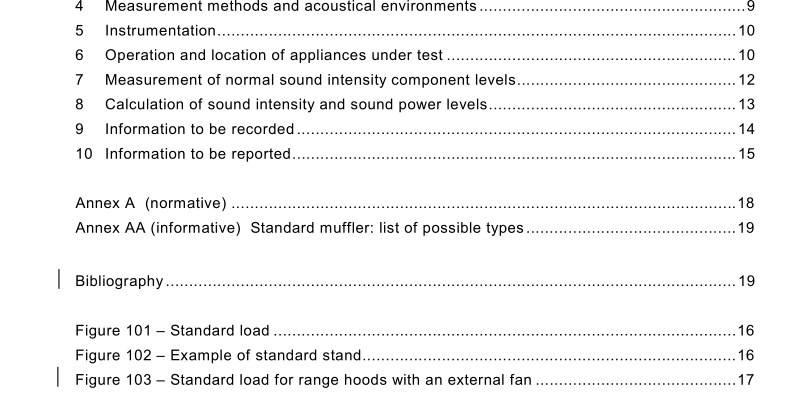IEC 60704-2-13:2008 pdf download – Household and similar electrical appliances – Test code for the determination of airborne acoustical noise – Part 2-13: Particular requirements for range hoods
4 Measurement methods and acoustical environments
This clause of part 1 is applicable except as follows:
4.1 General
Replacement:
The total noise emitted by machinery or equipment, and radiated in all directions to the space surrounding the machine, can be characterized by the sound power of the machine. The sound power of a machine is essentially independent of the environment in which the machine is installed. Therefore, the concept of sound power level has been chosen for expressing the noise emission of appliances for household and similar purposes. The preferred noise emission quantity is the A-weighted sound power level, in decibels (re. 1 pW). According to this standard, one method is used, the direct method as described in 4.2 below. 4.2 Direct method Addition: The measurement can be performed according to two intensimetric methods, the “discrete points method” and the “scanning method”, as described below.
4.2.1 01 Discrete points method Define, as the measurement surface, a parallelepiped-shaped surface around the range hood; then divide it in partial areas (segment) so as to obtain a grid. The dimension of the parallelepiped depends on the dimension of the range hood: the distance between each face of the parallelepiped and the range hood under test depends on the value of F 2 and F 3 indicators (see Annexes A and B of ISO 961 4-1 ) but shall be at least 1 0 cm. The density of measurement positions on parallelepiped faces depends on extraneous noise and on the value of the F 4 indicator (see Annexes A and B of ISO 961 4-1 ). The total sound power of the source is obtained from calculation of the partial sound power of each segment of the parallelepiped, by multiplying the “local” intensity sound by its partial area, and then by adding all the partial sound powers (absolute value).
4.2.1 02 Scanning method This method is very similar to the previous one (4.2.1 01 ), with the only difference being that each face of the parallelepiped is not divided in partial areas, but is continuously scanned with the intensimetric probe, and the space and time average of intensity sound is multiplied by its area; then the total sound power of the range hood is obtained by adding the partial sound powers of each face of the parallelepiped.
NOTE The distance of 20 cm between each face of the parallelepiped and the range hood is usually acceptable.
4.3 Comparison method
Addition:
Not applicable
4.4 Acoustical environments
4.4.1 General requirements and criterion for adequacy of the test environment
Replacement:
For the discrete points method, the general requirements and criterion for adequacy of the test environment are given in Clauses 4 and 5 of ISO 961 4-1 .
For the scanning method, they are given in Clauses 4 and 5 of ISO 961 4-2.
4.4.2 Criterion for background noise level
Not applicable.
5 Instrumentation
This clause of part 1 is applicable except as follows:
5.1 Instrumentation for measuring acoustical data
Addition:
The use of a windscreen is recommended and, if necessary, corrections for changes in the microphone sensitivity shall be added to the observed sound pressure levels.
Sound intensity measurement instruments and probes that meet the requirements of IEC 61 043 shall be used. Class 1 instruments shall be used.
To check the instrumentation for proper operation prior to each series of measurements, the field-check procedure specified by the manufacturer shall be applied.
6 Operation and location of appliances under test
This clause of part 1 is applicable except as follows:
6.1 Equipping and pre-conditioning of appliances
6.1 .1 Addition:
Recirculating-air range hoods should be fitted with a clean filter(s).
Air-extraction range hoods shall be fitted with the pipe coupling ring, if any, having the largest diameter among those provided by the manufacturer. If the range hood is designed to accommodate additional filters, those filters shall be clean and appropriately fitted.
6.1 .3 Replacement: Prior to noise measurements, the range hood shall have been in operation for running in for at least 4 h at the highest speed setting for normal use (see notes in 1 .2).
6.1 .4 Replacement: Immediately before each series of noise measurements, the range hood equipped for its intended use is operated for stabilizing at the highest speed setting for normal use (see notes in 1 .2) for 30 min.
